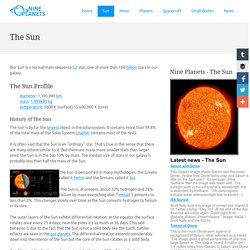

The Sun l Sun Facts and images. Our Sun is a normal main-sequence G2 star, one of more than 100 billion stars in our galaxy. diameter: 1,390,000 km. mass: 1.989e30 kgtemperature: 5800 K (surface) 15,600,000 K (core) History of The Sun The Sun is by far the largest object in the solar system.

It contains more than 99.8% of the total mass of the Solar System (Jupiter contains most of the rest). It is often said that the Sun is an "ordinary" star. The Sun is personified in many mythologies: the Greeks called it Helios and the Romans called it Sol. The Sun is, at present, about 70% hydrogen and 28% helium by mass everything else ("metals") amounts to less than 2%. The outer layers of the Sun exhibit differential rotation: at the equator the surface rotates once every 25.4 days; near the poles it's as much as 36 days.
Conditions at the Sun's core (approximately the inner 25% of its radius) are extreme. The Sun's power (about 386 billion billion mega Watts) is produced by nuclear fusion reactions. What Is The Sun? (Solar System) Have you ever wondered what the Sun is and where it came from?

Find out all there is to know in our VideoJug video. Our Sun is a star, just like all the other stars in the sky. It only seems bigger and brighter because it is so close to us. Our Sun was born 5 and a half billion years ago from a swirling mass of gases. As the gases grouped together the gravity became greater dragging more and more gases into it and the planets formed around this whirlpool.
Eventually the gases became so condensed; the heat and pressure became so great that a nuclear reaction took place. Hydrogen gas, which is what makes up 70% of the sun, began turning into helium gas. The Sun is not ‘burning' it is this massive nuclear reaction that makes it hot and bright. The Sun is so big it makes up 99% of the material in the Solar system. If we could take a slice through the sun we could see it is made from many different layers.
The central core is where the reaction of hydrogen into helium takes place. Sun. How the Sun Works" When’s the last time you gazed upward and marveled at the mysterious, life-giving force that is the sun?

If you believe the whole staring-at-the-sun-makes-you-go-blind thing (which is actually true), you’re probably not doing a whole lot of sun-gazing. But it’s a real marvel: The sun warms our planet every day, provides the light by which we see and is necessary for life on Earth. It can also cause cell death and make us blind. It could fit 1.3 million Earths inside its sphere [source: SpaceDaily]. It produces poem-worthy sunsets and as much energy as 1 trillion megaton bombs every second [source: Boston Globe].
All of this, and our sun is just a plain old average star, by universal standards. So, how close is the sun? If the sun is in the vacuum of space, how does it burn? In this article, we'll examine the fascinating world of our nearest star. The sun has "burned" for more than 4.5 billion years. We say the sun burns, but it doesn’t burn like wood burns.